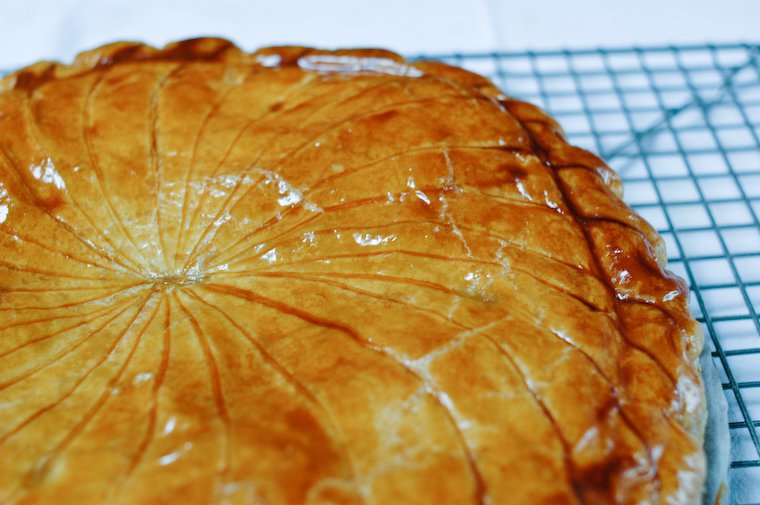Are you looking for a homemade galette des rois recipe?
It is a typically French tradition to celebrate l’Epiphanie: this holiday celebrates the day on which the three kings Gaspard, Balthazar and Melchior came to pay their tribute to the world-famous baby born just a couple of weeks before. In French those wise men go by the cool name of Les Rois Mages (the Magi), and their first names are totally coming back in fashion these days, let me tell you. (Well, except maybe for Melchior, that’s a tough one.)
Like many a Christian holiday, this one has lost its religious significance in most French families, gaining a sweeter, much more buttery one in the bargain: on the day of the Epiphany, families share a Galette des Rois, a flaked pastry pie filled with frangipane, a butter-rich, smooth mixture of crème d’amande (almond cream) and crème pâtissière (pastry cream)*.
The actual date on which to have the galette has gotten fuzzier and fuzzier: some families celebrate on the 6th, some on the first Sunday in January, but it’s mostly considered fine to celebrate it all through the month of January. (I must however protest against the sale of galettes before the new year, and sometimes as soon as November. I mean, really.)
The fabulous thing about a Galette des Rois, apart from its deliciousness, is the family ritual that goes with it: the youngest child of the family hides under the table, an adult divides the galette in even slices, and the child calls out which slice goes to whom.
Why all the fuss you ask? Aah, it is just this small thing I haven’t yet mentioned: la fève is hidden in the galette. Historically a dry fava bean (hence the name), it is now a little porcelain figure. (That figure used to have some kind of religious meaning but that, too, has gone the way of the dodo.) Whoever gets the fève in his serving is named King (or Queen) for the day, gets to wear the golden paper crown that came with the galette, picks who the Queen (or King) will be, and glows with pride for weeks hence.
In my family, both my sister and I would hide under the table because we loved it so (the view was much more interesting from there). My mother would be the official galette-slicer, always expertly avoiding to run the knife onto the fève, and making sure either Céline or I got it — until we got older and all of a sudden my father always seemed to get it. Go figure.
This year, for the first time ever, I invited my parents and my sister to share the family galette at my apartment. The minute I made the invitation I knew I was going to get a galette from Pierre Hermé: I ordered the plain one (which in my humble opinion is the only way to go, no pineapple or lychee in my galette thank you very much), picked it up, brought it home, opened the box, and admired its shiny golden puffiness with the eyes of love.
After a very simple dinner, I reheated the galette gently in the oven, set it on a serving plate, and brought it to the table. My father served us the excellent champagne he had brought, my sister went to hide under the table (we are still little girls at heart, even after a long day at work), and for the first time of my life, I cut the galette and served a first round of slices, following the instructions my sister called out.
I very quickly spotted the tell-tale white spot on the side of my slice (“Yay, I have it!” thought I, beside myself with excitement), but for the sake of the game I hid it in my napkin until we had all had seconds: the second slice doesn’t taste half as good if the fève has already been discovered, and it is the Queen’s duty to make sure her people enjoy themselves, no?
Verdict: that galette was far and away the best any of us had ever tasted. The pastry was delicately flaky, rich and buttery but not overwhelmingly so, and the frangipane was soft, flavorful, and simply marvellous. Certainly worth the extra euros.
* In the south of France, it is customary to eat a Gâteau des Rois instead, a ring-shaped brioche garnished with candied fruit.














